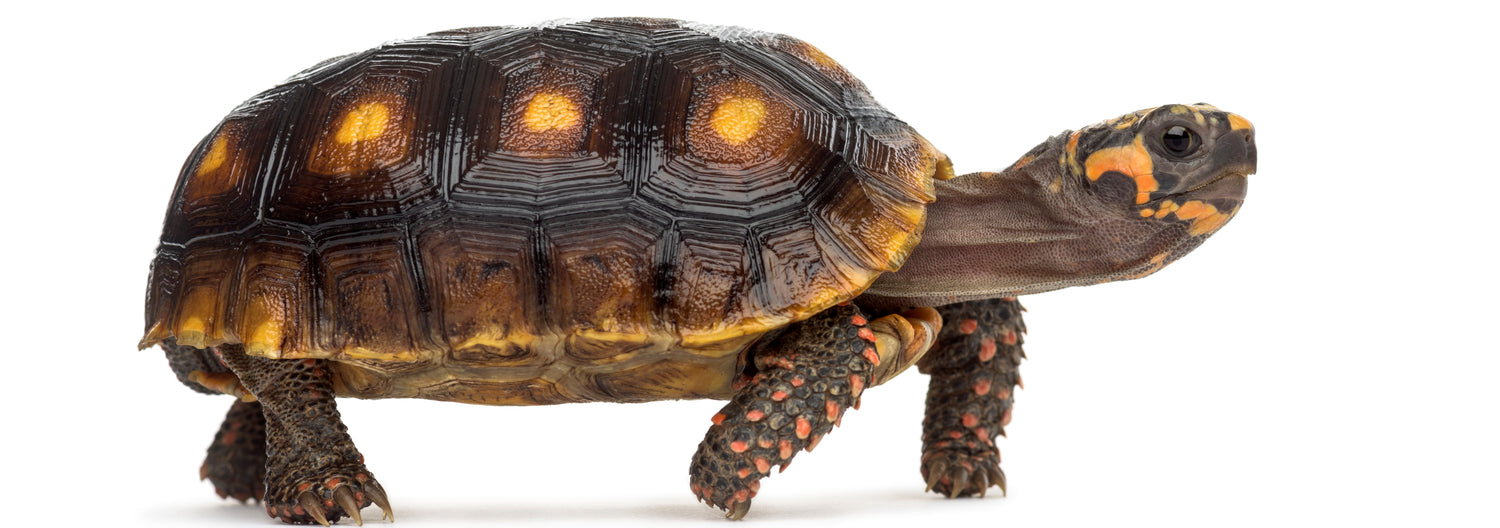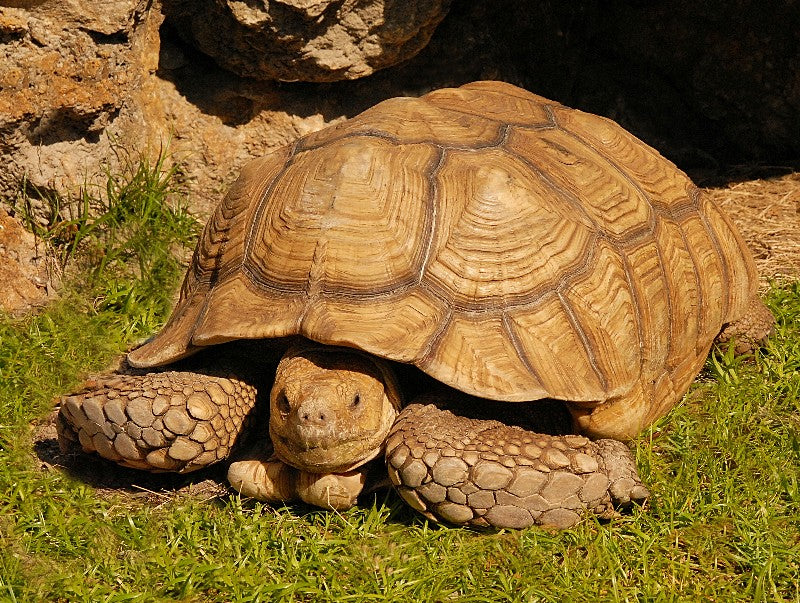Red-footed tortoises (Chelonoidis carbonarius) are a medium-sized tortoise species native to South America. They generally prefer heavily forested, humid habitats, but they are also known to inhabit savanna areas.
Red-footed tortoises’ appearance varies based on locality, but they generally have a dark brown or black-brown shell, with a pale spot on each scute, and a pale to dark yellow plastron. One of their identifying characteristics is the yellow or red-orange scales on their limbs and tail. Males have an hourglass shape to their shell, while females are more rectangular. Adults are generally 12-18” long, but they are capable of growing larger — the largest known red-footed tortoise was 24” long!
Red-footed tortoises are among the most popular pet tortoises in the US. As a larger tortoise they are not suitable for a keeper who doesn’t have a lot of available space, but they can be very rewarding. With good care, a red-footed tortoise can live 50 years or more!
How much space do red-footed tortoises need?
A single red-footed tortoise should have no less than 24 square feet of floor space. Like most tortoises, they are poor climbers and as such floor space is the most important consideration for an enclosure. Because of high humidity requirements, it is best to house them in a fully-enclosed setup rather than an open tortoise table, unless they are being housed outdoors.
Red-footed tortoises seem to do well in groups, so they can be housed together if desired. You will need to add about 16 square feet of extra floor space for each additional tortoise after two. However, cohabitation is not required, and red-footed tortoises are perfectly happy with being solitary as well.
Do red-footed tortoises need UVB?
Yes. Aside from helping provide a day/night cycle and an infinite supply of vitamin D, UVB is also essential to your tortoise’s overall health. The best UVB bulbs for red-footed tortoises are:
When the bulb is mounted in a Zoo Med Reptisun T5 HO Terrarium Hood fixture without mesh obstruction, it should be placed 6-8” above the top of the tortoise’s shell in the basking area. Bulbs mounted in the Arcadia ProT5 fixture can be placed further away: 15-24” above the tortoise’s shell.
The UVB bulb and fixture should be roughly half the total length of the enclosure.
If your red-footed tortoise is being housed outside and has access to direct sunlight, artificial UVB lighting is not required.
Because a large enclosure is required for red-footed tortoises, if you are housing yours indoors, a single UVB bulb will not be enough to sufficiently illuminate the enclosure. Add a strong 6500K LED or T5 HO fluorescent grow light to energize your tortoise and better simulate daylight.
What basking temperatures do red-footed tortoises need?
Red-footed tortoises should have a basking temperature of 95°F, with a cool/shaded area on the other side of the enclosure between 75-80°F. Temperature should be measured with digital probe thermometers.
Because of their size and large, domed shells, it’s best to create a basking area for your red-footed tortoise with a cluster of at least two halogen heat lamps placed on one side of the enclosure, mounted at least 8” above your tortoise’s shell to provide more even heating.
Do not use ceramic heat emitters (CHEs), heat mats, red bulbs, or blue bulbs, as these are not as effective.
What humidity levels do red-footed tortoises need?
Red-footed tortoises should have an average humidity of 70-80%. As a tropical species, they need consistently high humidity in their environment to stay healthy. This is especially important for developing a smooth shell in young red-footed tortoises.
To help maintain high humidity levels, mist your enclosure 2-3x/day with a spray bottle and use a thick layer of humidity-retentive substrate. Automatic misting systems can be very helpful. You will also need to provide a humid hideout lined with moistened substrate or sphagnum moss and placed in the middle to cool end of the enclosure.
Humidity should be measured by a digital probe hygrometer with the probe in the middle of the terrarium.
What substrate is good for red-footed tortoises?
Substrate covers the floor of your enclosure and helps make the setup more attractive, but it also helps maintain higher humidity levels and provides something for your tortoise to dig in as desired.
It’s ideal to use a substrate that imitates what red-footed tortoises naturally live on in the wild. In other words, you’ll need something that resembles soil. It should have small particles, hold moisture well, and be loose enough to dig in.
We recommend the following substrates for red-footed tortoises:
Layering clean, chemical-free leaf litter on top of the substrate helps with humidity as well as add enrichment value.
Substrate should be at least 4”-6” deep and completely replaced every 3-4 months. Remove poop and urates daily, along with contaminated substrate.
What décor can you use in a red-footed tortoise enclosure?
It’s terribly boring for a reptile to be stuck in an enclosure with nothing in it except substrate and food/water bowls. It doesn’t matter how big the enclosure is if you don’t put things in it for your pet to use and interact with.
Here are some décor ideas that are appropriate for red-footed tortoises:
- additional hiding places/burrows
- large hollow logs
- live, edible plants
- large, flat stones
What do red-footed tortoises eat?
Red-footed tortoises are primarily herbivorous, and as such require a high-fiber diet. But they also need a small amount of animal matter in their diet to get the right nutrition. For best health, offer a balance of 40% fruit, 40% greens, and <20% low-fat animal protein.
Safe fruits for red-footed tortoises: apples, berries, melons, papaya, guava, pineapple, bananas, cactus fruit, grapes, plums, peaches
Safe vegetables for red-footed tortoises: cactus pads, kale, collard greens, turnip greens, mustard greens, dandelion greens + flowers, watercress, broccoli, escarole, swiss chard, parsley, spinach, endive, romaine lettuce, hibiscus leaves + flowers, nasturtium, honeysuckle
Protein sources for red-footed tortoises: earthworms, mealworms, canned crickets, canned roaches, young pre-killed feeder mice, bone-in chicken pieces (cooked), beef heart, wet cat food
Young and growing tortoises younger than 5 years old should be fed daily, while tortoises older than 5 years should be fed every other day.
Supplements
You will also need calcium and vitamin supplements to prevent your tortoise from developing a potential deficiency. We recommend Repashy Calcium Plus LoD, lightly dusted on each meal. A little bit of Mazuri tortoise diet is also a good way to make sure your tortoise is getting enough vitamins.
Water
Of course, don’t forget a water bowl for your tortoise to drink from! Red-footed tortoises like to soak, so it’s best to offer a shallow “puddle” of water for them to soak and defecate in (cat litter trays work well for this) and a smaller water bowl for them to drink from. Change the water daily and scrub the bowl with a reptile-safe disinfectant weekly, or whenever it becomes soiled.
Do red-footed tortoises like to be handled?
Few reptiles actually “like” to be held, but red-footed tortoises generally tolerate human interaction well, especially individuals that were bred in captivity. Never grab a tortoise from above, as that will scare it. Instead, approach from the side and scoop from below. Support as much of its body as possible. Start with very short handling sessions in the beginning, then gradually make them longer as your pet becomes more accustomed to you.
Many pet red-footed tortoises learn to recognize their keepers and will come running for food.
*This care sheet contains only very basic information. Although it’s a good introduction, please do further research with high-quality sources to obtain additional information on caring for this species.



Leave a comment
This site is protected by hCaptcha and the hCaptcha Privacy Policy and Terms of Service apply.